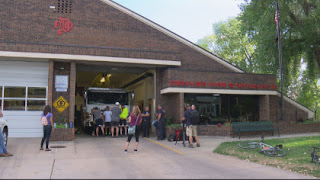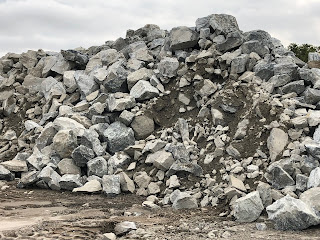It's funny how a bit of travel can make you see a familiar bike ride in a new way.
So, for that matter, can doing the ride with new partners--or with partners if you'd previously done it solo.
That's how I found myself seeing the roads and trails of the Palisades when I pedaled them with Bill and Cindy the other day.
It's also the first time I've ridden with either of them in a while: They've been spending their weekends in a secret hideaway they told me about.
Seeing this plant--a giant fern, a small tree or something else--made me visualize, if for a moment, some of the flora and fauna I saw while riding in Cambodia.
And this sheer rock face made me forget--even though I've seen it before--that it's just across the river from the Cloisters--which, in turn, can make you forget that you're in Upper Manhattan.
The further you ride into the trails, and the closer you get to the river, the easier it is to feel you're not within a few kilometers of the George Washington Bridge.
But something one of them said really made me see this old familiar ride in a new way: "You can almost imagine what it was like when the native people lived here."
Yes, sheer rock faces and colorful plants seem like eons as well as worlds away from the West Side Highway. It almost seems possible to remember that whatever structures were in the area weren't made of steel or glass--or even brick.
As we were imagining people who are long gone and vistas changed, I found myself thinking back to Cambodia, where most of the population are Khmers, the people who have lived on that land for milennia. Much of their landscape hasn't changed in centuries, whether in jungles that haven't been touched or the Angkor Wat and other temples, which were standing for centuries before the land we rode yesterday was called "New Jersey" and the other side of the river was named "New York", or even "New Amsterdam."
Those temples still stand today, seemingly as much a part of the land as the rock face we saw.
Note: The penultimate photo was not, of course, taken on the New Jersey Palisades. The others, however, were.
The Angkor Wat photo, as well as the first two in this post and the "blueberry" photo near the end, were taken by me. Bill took the others.
So, for that matter, can doing the ride with new partners--or with partners if you'd previously done it solo.
That's how I found myself seeing the roads and trails of the Palisades when I pedaled them with Bill and Cindy the other day.
It's also the first time I've ridden with either of them in a while: They've been spending their weekends in a secret hideaway they told me about.
Seeing this plant--a giant fern, a small tree or something else--made me visualize, if for a moment, some of the flora and fauna I saw while riding in Cambodia.
And this sheer rock face made me forget--even though I've seen it before--that it's just across the river from the Cloisters--which, in turn, can make you forget that you're in Upper Manhattan.
The further you ride into the trails, and the closer you get to the river, the easier it is to feel you're not within a few kilometers of the George Washington Bridge.
But something one of them said really made me see this old familiar ride in a new way: "You can almost imagine what it was like when the native people lived here."
Yes, sheer rock faces and colorful plants seem like eons as well as worlds away from the West Side Highway. It almost seems possible to remember that whatever structures were in the area weren't made of steel or glass--or even brick.
As we were imagining people who are long gone and vistas changed, I found myself thinking back to Cambodia, where most of the population are Khmers, the people who have lived on that land for milennia. Much of their landscape hasn't changed in centuries, whether in jungles that haven't been touched or the Angkor Wat and other temples, which were standing for centuries before the land we rode yesterday was called "New Jersey" and the other side of the river was named "New York", or even "New Amsterdam."
Those temples still stand today, seemingly as much a part of the land as the rock face we saw.
Note: The penultimate photo was not, of course, taken on the New Jersey Palisades. The others, however, were.
The Angkor Wat photo, as well as the first two in this post and the "blueberry" photo near the end, were taken by me. Bill took the others.






































